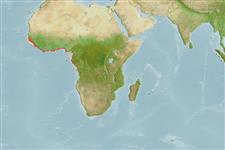>
Eupercaria/misc (Various families in series Eupercaria) >
Lutjanidae (Snappers) > Lutjaninae
Etymology: Lutjanus: Malay, ikan lutjan, name of a fish.
More on author: Bleeker.
Environment: milieu / climate zone / depth range / distribution range
Écologie
marin; saumâtre récifal. Tropical; 13°N - 20°S, 21°W - 17°E (Ref. 55)
Taille / Poids / Âge
Maturity: Lm ? range ? - ? cm
Max length : 139 cm TL mâle / non sexé; (Ref. 40637); common length : 50.0 cm TL mâle / non sexé; (Ref. 55); poids max. publié: 60.0 kg (Ref. 40637)
Description synthétique
Morphologie | Morphométrie
Épines dorsales (Total): 10; Rayons mous dorsaux (Total): 13-14; Épines anales 3; Rayons mous anaux: 8. Diagnosis: head pointed; gape of mouth wide (Ref. 57393). Body relatively deep; dorsal head profile straight or somewhat concave; lachrymal bone broad (Ref. 81653). Maxilla extending nearly to mid-eye level (Ref. 55, 57393, 81653). Vomerine tooth plate triangular, sometimes with a short postero-median extension (Ref. 57393, 81653). Preopercular notch and knob weak; pectoral fins of adults not reaching level of anus (Ref. 55, 81653). Scales medium-sized; 5 or 6 transverse scale rows on cheeks (Ref. 57393, 81653). Scale rows on back parallel to lateral line (Ref. 55, 57393, 81653), 4 rows below middle of spinous part of dorsal fin (Ref. 57393, 81653). Reddish brown to slightly orange on back and upper sides, grading to pink or whitish on lower sides and belly; tips of pelvic fins very dark (Ref. 55, 57393, 81653). No blue line on cheeks (Ref. 57393, 81653). Juveniles with a series of about 6 to 8 vertical rows of small white spots or narrow bars on side (Ref. 55, 57393, 81653).
Adults inhabit rocky bottoms and (inshore) coral reefs; also common in brackish lagoons and found in lower courses of rivers, particularly juveniles (Ref. 55, 57393, 81653). Marketed fresh.
Life cycle and mating behavior
Maturité | Reproduction | Frai | Œufs | Fécondité | Larves
Allen, G.R., 1985. FAO Species Catalogue. Vol. 6. Snappers of the world. An annotated and illustrated catalogue of lutjanid species known to date. FAO Fish. Synop. 125(6):208 p. Rome: FAO. (Ref. 55)
Statut dans la liste rouge de l'IUCN (Ref. 130435)
Menace pour l'homme
Harmless
Utilisations par l'homme
Pêcheries: intérêt commercial mineur; pêche sportive: oui
Plus d'informations
Noms communsSynonymesMétabolismePrédateursÉcotoxicologieReproductionMaturitéFraiRassemblement de ponteFéconditéŒufsDéveloppement de l'œuf
RéférencesAquacultureProfil d'aquacultureSouchesGénétiqueElectrophoresesHéritabilitéPathologiesTraitementNutrientsMass conversion
CollaborateursImagesStamps, Coins Misc.SonsCiguateraVitesseType de nageSurface branchialeOtolithesCerveauxVision
Outils
Articles particuliers
Télécharger en XML
Sources Internet
Estimates based on models
Preferred temperature (Ref.
123201): 25.8 - 28, mean 27.5 °C (based on 153 cells).
Phylogenetic diversity index (Ref.
82804): PD
50 = 0.5000 [Uniqueness, from 0.5 = low to 2.0 = high].
Bayesian length-weight: a=0.01288 (0.00767 - 0.02165), b=2.90 (2.76 - 3.04), in cm total length, based on LWR estimates for this species & Genus-body shape (Ref.
93245).
Niveau trophique (Ref.
69278): 4.0 ±0.66 se; based on food items.
Résilience (Ref.
120179): Très faible, temps minimum de doublement de population supérieur à 14 ans (Preliminary K or Fecundity.).
Fishing Vulnerability (Ref.
59153): Very high vulnerability (83 of 100).
Nutrients (Ref.
124155): Calcium = 16.3 [10.0, 24.2] mg/100g; Iron = 0.248 [0.157, 0.387] mg/100g; Protein = 18.9 [17.4, 20.2] %; Omega3 = 0.122 [0.086, 0.171] g/100g; Selenium = 79.4 [50.1, 122.6] μg/100g; VitaminA = 84.9 [15.3, 311.2] μg/100g; Zinc = 0.404 [0.321, 0.543] mg/100g (wet weight);
